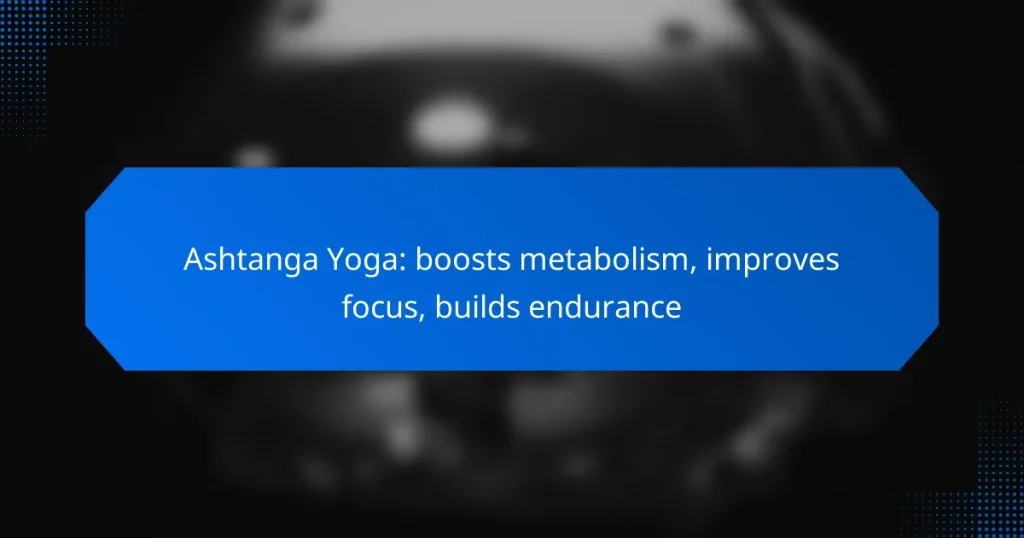Exploring various yoga styles reveals a multitude of benefits tailored to different needs and preferences. From the calming practices of Hatha Yoga to the dynamic flow of Vinyasa and the structured sequences of Ashtanga, each style offers unique advantages for physical fitness, mental clarity, and emotional stability. Understanding these benefits can help practitioners choose the right approach to enhance their overall well-being.
Ashtanga Yoga: boosts metabolism, improves focus, builds endurance
What are the benefits of Hatha Yoga?
Hatha Yoga offers numerous benefits, focusing on physical postures and breathing techniques to promote overall well-being. Practicing Hatha Yoga can enhance flexibility, reduce stress, build muscle strength, improve posture, and increase mindfulness.
Improved flexibility
Hatha Yoga is particularly effective for improving flexibility due to its emphasis on various poses that stretch and lengthen muscles. Regular practice can lead to noticeable increases in range of motion, making everyday activities easier and reducing the risk of injury.
To maximize flexibility gains, aim for at least two to three sessions per week, holding each pose for 20-30 seconds. Gradually increase the duration as your body adapts.
Stress reduction
One of the key benefits of Hatha Yoga is its ability to reduce stress through mindful breathing and relaxation techniques. These practices activate the body’s relaxation response, helping to lower cortisol levels and promote a sense of calm.
Incorporating deep breathing exercises and meditation into your routine can enhance these stress-relieving effects. Consider dedicating the last few minutes of your practice to quiet reflection or guided meditation.
Enhanced muscle strength
Hatha Yoga builds muscle strength by engaging various muscle groups during poses. Many postures require you to support your body weight, which helps develop strength over time.
Focus on poses like Plank, Warrior, and Downward Dog to target major muscle groups. Aim for a balanced routine that includes both strength-building and flexibility-enhancing poses for optimal results.
Better posture
Practicing Hatha Yoga can lead to improved posture by strengthening the muscles that support the spine and increasing body awareness. Many poses encourage alignment and balance, which can help correct postural imbalances.
To enhance posture, incorporate poses such as Mountain, Cat-Cow, and Bridge into your practice. Regularly check in with your alignment during daily activities to reinforce good habits.
Increased mindfulness
Hatha Yoga fosters mindfulness by encouraging practitioners to focus on their breath and body sensations. This heightened awareness can lead to a greater understanding of oneself and improved mental clarity.
To cultivate mindfulness, practice being present during your yoga sessions. Limit distractions and focus solely on your movements and breath, allowing thoughts to come and go without attachment.
How does Vinyasa Yoga benefit practitioners?
Vinyasa Yoga offers numerous benefits, particularly in enhancing physical fitness and mental well-being. This dynamic style of yoga emphasizes breath-synchronized movement, which can lead to improved overall health and vitality.
Boosted cardiovascular health
Practicing Vinyasa Yoga can significantly improve cardiovascular health by increasing heart rate and promoting circulation. The continuous flow of movements elevates the heart rate, providing a workout that can be comparable to moderate aerobic exercise.
Regular practice may help lower blood pressure and improve cholesterol levels, contributing to a healthier heart. Aim for at least three sessions per week to maximize these cardiovascular benefits.
Improved coordination
Vinyasa Yoga enhances coordination by requiring practitioners to transition smoothly between poses while maintaining balance and alignment. This practice encourages body awareness and control, which can translate into better coordination in daily activities.
Incorporating balance-focused poses, such as Tree Pose or Warrior III, can further develop this skill. Consistent practice helps refine motor skills and improves overall physical performance.
Enhanced mental clarity
Engaging in Vinyasa Yoga can lead to enhanced mental clarity through its focus on breath and movement. The meditative aspect of synchronizing breath with flow helps clear the mind, reducing stress and anxiety.
Practitioners often report improved concentration and cognitive function after sessions. Setting aside time for Vinyasa Yoga can be a powerful tool for mental rejuvenation, especially during busy periods.
Increased energy levels
Vinyasa Yoga can boost energy levels by promoting circulation and oxygen flow throughout the body. The dynamic movements stimulate the nervous system, leading to increased alertness and vitality.
To experience these energy benefits, consider practicing in the morning or during midday slumps. A short 20-30 minute session can be enough to recharge and invigorate your day.
What advantages does Ashtanga Yoga offer?
Ashtanga Yoga provides numerous benefits, including enhanced physical fitness, mental clarity, and emotional stability. This dynamic style emphasizes a structured sequence of postures, promoting a holistic approach to well-being.
Increased stamina
Practicing Ashtanga Yoga can significantly boost your stamina by engaging multiple muscle groups and improving cardiovascular health. The continuous flow of movements requires sustained energy, which helps build endurance over time.
To maximize stamina gains, aim for consistent practice, ideally three to five times a week. Gradually increase the duration of your sessions, starting with 30 minutes and working up to 90 minutes or more as your body adapts.
Improved discipline
Ashtanga Yoga fosters discipline through its structured sequence and commitment to a regular practice schedule. Adhering to the same series of postures encourages focus and determination, essential traits for personal growth.
To enhance discipline, set specific goals for your practice, such as mastering a particular pose or increasing your session frequency. Keeping a yoga journal can help track progress and maintain motivation.
Enhanced physical endurance
Ashtanga Yoga enhances physical endurance by combining strength, flexibility, and balance in its sequences. This comprehensive approach challenges the body, leading to improved performance in other physical activities.
Incorporate breath control techniques, known as Ujjayi breathing, during your practice to further increase endurance. This method helps regulate energy levels and maintain stamina throughout your sessions.
How does Bikram Yoga impact health?
Bikram Yoga, practiced in a heated room, significantly impacts health by promoting detoxification, improving joint health, and enhancing lung capacity. The combination of heat and specific postures encourages physical and mental benefits that can lead to overall wellness.
Detoxification through sweating
The high temperatures in Bikram Yoga facilitate sweating, which is a natural method for the body to eliminate toxins. As practitioners move through the series of poses, the body releases impurities through sweat, potentially leading to clearer skin and improved metabolic function.
To maximize detoxification, it’s crucial to stay hydrated before and after class. Drinking water and electrolyte-rich beverages can help replenish lost fluids and support the body’s recovery process.
Improved joint health
Bikram Yoga can enhance joint health by increasing flexibility and promoting better circulation. The heat allows muscles and connective tissues to loosen, reducing stiffness and the risk of injury during practice.
Regular practice may lead to improved range of motion in joints, which is beneficial for individuals with arthritis or other joint-related issues. However, it’s important to listen to your body and avoid pushing through pain to prevent strain.
Enhanced lung capacity
Practicing Bikram Yoga can improve lung capacity through controlled breathing techniques integrated into the poses. The focus on deep, rhythmic breathing helps strengthen the respiratory system and increases oxygen intake.
To enhance lung capacity further, consider incorporating pranayama (breath control) exercises into your routine. This can complement the benefits gained from the physical practice and promote overall respiratory health.
What are the unique benefits of Yin Yoga?
Yin Yoga offers a range of unique benefits, primarily focusing on deep tissue stretching and relaxation. This style emphasizes long-held postures that target the connective tissues, promoting flexibility and mental calmness.
Deep relaxation
Yin Yoga is particularly effective for inducing deep relaxation, as it encourages practitioners to hold poses for extended periods, typically between three to five minutes. This prolonged duration allows the body to release tension and stress, leading to a state of tranquility.
To maximize relaxation, focus on your breath while in each pose. Deep, slow breathing can enhance the calming effects, making it easier to let go of physical and mental stressors. Consider incorporating props like bolsters or blankets to support your body and deepen your relaxation experience.
Common pitfalls include rushing through poses or holding them without mindfulness. To avoid this, set an intention for your practice and remind yourself to stay present. Regular practice can significantly improve your ability to relax and manage stress over time.

